Climate-Induced Perspective Variations in Irrigation Schedules and Design Water Requirements for the Rice–Wheat System
Abstract
:1. Introduction
2. Materials and Methods
2.1. Study Area
2.2. Climate Data
2.3. Estimation of Crop Water Requirements and Irrigation Scheduling
2.4. Trend Analysis
2.5. Estimation of the Design Water Requirement
3. Results
3.1. Projected Climate Change
3.2. Comparison of CROPWAT Results with the Literature
3.3. Projected Wheat Irrigation Schedules
3.4. Projected Rice Irrigation Schedules
3.5. Projected Change in Design Water Requirements
4. Discussion
5. Conclusions
Supplementary Materials
Author Contributions
Funding
Conflicts of Interest
References
- IPCC. Summary for Policymakers. In Climate Change 2021: The Physical Science Basis. Contribution of Working Group I to the Sixth Assessment Report of the Intergovernmental Panel on Climate Change; Masson-Delmotte, V.P., Zhai, A., Pirani, S.L., Connors, C., Péan, S., Berger, N., Caud, Y., Chen, L., Goldfarb, M.I., Gomis, M., et al., Eds.; Cambridge University Press: Cambridge, UK, 2021. [Google Scholar]
- Azmat, M.; Ilyas, F.; Sarwar, A.; Huggel, C.; Vaghefi, S.A.; Hui, T.; Qamar, M.U.; Bilal, M.; Ahmed, Z. Impacts of climate change on wheat phenology and yield in Indus Basin, Pakistan. Sci. Total Environ. 2021, 790, 148221. [Google Scholar] [CrossRef]
- Ahmad, M.J.; Choi, K.-S.; Cho, G.-H.; Kim, S.-H. Future Wheat Yield Variabilities and Water Footprints Based on the Yield Sensitivity to Past Climate Conditions. Agronomy 2019, 9, 744. [Google Scholar] [CrossRef] [Green Version]
- Wang, X.-J.; Zhang, J.-Y.; Ali, M.; Shahid, S.; He, R.-M.; Xia, X.-H.; Jiang, Z. Impact of climate change on regional irrigation water demand in Baojixia irrigation district of China. Mitig. Adapt. Strateg. Glob. Chang. 2016, 21, 233–247. [Google Scholar] [CrossRef]
- Ahmed, K.; Shahid, S.; Nawaz, N. Impacts of climate variability and change on seasonal drought characteristics of Pakistan. Atmos. Res. 2018, 214, 364–374. [Google Scholar] [CrossRef]
- Ahmad, M.J.; Iqbal, M.A.; Choi, K.S. Climate-driven constraints in sustaining future wheat yield and water productivity. Agric. Water Manag. 2020, 231, 105991. [Google Scholar] [CrossRef]
- Ahmad, M.J.; Cho, G.-H.; Kim, S.-H.; Lee, S.; Adelodun, B.; Choi, K.-S. Influence mechanism of climate change over crop growth and water demands for wheat-rice system of Punjab, Pakistan. J. Water Clim. Chang. 2020, 12, 1184–1202. [Google Scholar] [CrossRef]
- Asseng, S.; Ewert, F.; Martre, P.; Rötter, R.P.; Lobell, D.B.; Cammarano, D.; Kimball, B.A.; Ottman, M.J.; Wall, G.W.; White, J.W.; et al. Rising temperatures reduce global wheat production. Nat. Clim. Change 2015, 5, 143–147. [Google Scholar] [CrossRef]
- Alvar-Beltrán, J.; Heureux, A.; Soldan, R.; Manzanas, R.; Khan, B.; Dalla Marta, A. Assessing the impact of climate change on wheat and sugarcane with the AquaCrop model along the Indus River Basin, Pakistan. Agric. Water Manag. 2021, 253, 106909. [Google Scholar] [CrossRef]
- Akhtar, I.U.H.; Athar, H. Water supply and effective rainfall impacts on major crops across irrigated areas of Punjab, Pakistan. Theor. Appl. Climatol. 2020, 142, 1097–1116. [Google Scholar] [CrossRef]
- Khaliq, T.; Gaydon, D.S.; Ahmad, M.-U.-D.; Cheema, M.J.M.; Gull, U. Analyzing crop yield gaps and their causes using cropping systems modelling–A case study of the Punjab rice-wheat system, Pakistan. Field Crops Res. 2019, 232, 119–130. [Google Scholar] [CrossRef]
- Kirby, M.; Ahmad, M.-U.-D.; Mainuddin, M.; Khaliq, T.; Cheema, M.J.M. Agricultural production, water use and food availability in Pakistan: Historical trends, and projections to 2050. Agric. Water Manag. 2017, 179, 34–46. [Google Scholar] [CrossRef]
- Habib, Z.; Wahaj, R. Water Availability, Use and Challenges in Pakistan—Water Sector Challenges in the Indus Basin and Impact of Climate Change; FAO: Rome, Italy, 2021. [Google Scholar]
- Shahid, M.R.; Wakeel, A.; Ishaque, W.; Ali, S.; Soomro, K.B.; Awais, M. Optimizing different adaptive strategies by using crop growth modeling under IPCC climate change scenarios for sustainable wheat production. Environ. Dev. Sustain. 2021, 23, 11310–11334. [Google Scholar] [CrossRef]
- Hussain, J.; Khaliq, T.; Ahmad, A.; Akhter, J.; Asseng, S. Wheat Responses to Climate Change and Its Adaptations: A Focus on Arid and Semi-arid Environment. Internat. J. Environ. Res. 2018, 12, 117–126. [Google Scholar] [CrossRef]
- Arshad, A.; Zhang, Z.; Zhang, W.; Gujree, I. Long-Term Perspective Changes in Crop Irrigation Requirement Caused by Climate and Agriculture Land Use Changes in Rechna Doab, Pakistan. Water 2019, 11, 1567. [Google Scholar] [CrossRef] [Green Version]
- Ahmad, M.J.; Choi, K.S. Climatic influence on the water requirement of wheat-rice cropping system in UCC command area of Pakistan. J. Korean Soc. Agric. Eng. 2018, 60, 69–80. [Google Scholar] [CrossRef]
- Ahmad, S.; Abbas, G.; Ahmed, M.; Fatima, Z.; Anjum, M.A.; Rasul, G.; Khan, M.A.; Hoogenboom, G. Climate warming and management impact on the change of phenology of the rice-wheat cropping system in Punjab, Pakistan. Field Crops Res. 2019, 230, 46–61. [Google Scholar] [CrossRef]
- Shabbir, G.; Khaliq, T.; Ahmad, A.; Saqib, M. Assessing the climate change impacts and adaptation strategies for rice production in Punjab, Pakistan. Environ. Sci. Pollut. Res. 2020, 27, 22568–22578. [Google Scholar] [CrossRef]
- Khan, S.; Rasool, A.; Irshad, S.; Hafeez, M.B.; Ali, M.; Saddique, M.; Asif, M.; Hasnain, Z.; Naseem, S.; Alwahibi, M.S.; et al. Potential soil moisture deficit: A useful approach to save water with enhanced growth and productivity of wheat crop. J. Water Clim. Chang. 2021. [Google Scholar] [CrossRef]
- Yasin, H.Q.; Akram, M.M.; Tahir, M.N. High Efficiency Irrigation Technology as a Single Solution for Multi-Challenge. In Water, Climate Change and Sustainability; John Wiley & Sons, Inc.: Hoboken, NJ, USA, 2021; Chapter 12; pp. 185–196. [Google Scholar] [CrossRef]
- Hussain, I.; Ali, A.; Ahmed, A.; Nasrullah, H.; Iqbal, S.; Aulakh, A.M.; Akhter, J.; Ahmed, G. Impact of Ridge-Furrow Planting in Pakistan: Empirical Evidence from the Farmers Field. Int. J. Agron. 2018, 2018, 3798037. [Google Scholar] [CrossRef] [Green Version]
- Gaydon, D.S.; Khaliq, T.; Ahmad, M.-U.-D.; Cheema, M.J.M.; Gull, U. Tweaking Pakistani Punjab rice-wheat management to maximize productivity within nitrate leaching limits. Field Crops Res. 2021, 260, 107964. [Google Scholar] [CrossRef]
- Shakir, A.; Khan, N.; Qureshi, M. Canal water management: Case study of upper Chenab Canal in Pakistan. Irrig. Drain. 2010, 59, 76–91. [Google Scholar] [CrossRef]
- Fuka, D.R.; Walter, M.T.; MacAlister, C.; Degaetano, A.T.; Steenhuis, T.S.; Easton, Z.M. Using the Climate Forecast System Reanalysis as weather input data for watershed models. Hydrol. Process. 2013, 28, 5613–5623. [Google Scholar] [CrossRef]
- Dile, Y.T.; Srinivasan, R. Evaluation of CFSR climate data for hydrologic prediction in data-scarce watersheds: An application in the Blue Nile River Basin. J. Am. Water Resour. As. 2014, 50, 1226–1241. [Google Scholar] [CrossRef]
- Saha, S.; Moorthi, S.; Pan, H.L.; Wu, X.; Wang, J.; Nadiga, S.; Tripp, P.; Kistler, R.; Woollen, J.; Behringer, D.; et al. The NCEP Climate Forecast System Reanalysis. Bull. Amer. Meteorol. Soc. 2010, 91, 1015–1058. [Google Scholar] [CrossRef]
- Miao, C.; Su, L.; Sun, Q.; Duan, Q. A nonstationary bias-correction technique to remove bias in GCM simulations. J. Geophys. Res. Atmos. 2016, 121, 5718–5735. [Google Scholar] [CrossRef]
- Rajczak, J.; Kotlarski, S.; Salzmann, N.; Schär, C. Robust climate scenarios for sites with sparse observations: A two-step bias correction approach. Int. J. Climatol. 2016, 36, 1226–1243. [Google Scholar] [CrossRef] [Green Version]
- Pereira, L.S.; Allen, R.G.; Smith, M.; Raes, D. Crop evapotranspiration estimation with FAO56: Past and future. Agric. Water Manag. 2015, 147, 4–20. [Google Scholar] [CrossRef]
- Allen, R.G.; Pereira, L.S.; Raes, D.; Smith, M. Crop Evapotranspiration: Guidelines for Computing Crop Water Requirements; FAO Irrigation and Drainage Paper 56; FAO: Rome, Italy, 1998. [Google Scholar]
- Ullah, M.K.; Habib, Z.; Muhammad, S. Spatial Distribution of Reference and Potential Evapotranspiration across the Indus Basin Irrigation Systems; International Water Management Institute (IWMI): Anand, India, 2001. [Google Scholar]
- Smith, M. CROPWAT: A Computer Program for Irrigation Planning and Management; Food & Agriculture Organisation of United Nations: Rome, Italy, 1992. [Google Scholar]
- Pereira, L.S.; Paredes, P.; Jovanovic, N. Soil water balance models for determining crop water and irrigation requirements and irrigation scheduling focusing on the FAO56 method and the dual Kc approach. Agric. Water Manag. 2020, 241, 106357. [Google Scholar] [CrossRef]
- Soomro, Z.A.; Ashraf, M.; Ejaz, K.; Bhatti, A.Z. Water Requirements of Major Crops in the Central Punjab; Pakistan Council of Research in Water Resources (PCRWR): Lahore, Pakistan, 2018; p. 44. [Google Scholar]
- Aslam, M.; Qureshi, A.S.; Horinkova, V.M. Water saving strategies for irrigated rice. J. Drain. Water Manag. 2002, 6, 25–36. [Google Scholar]
- Soomro, Z.A.; Arshad, M.D.; Ejaz, K.; Bhatti, A.Z.; Ashraf, M. Rice Cultivation on Beds—An Efficient and Viable Irrigation Practice; Pakistan Council of Research in Water Resources (PCRWR): Lahore, Pakistan, 2015; p. 24. [Google Scholar]
- Chapagain, A.K.; Hoekstra, A.Y. The blue, green and grey water footprint of rice from production and consumption perspectives. Ecol. Econom. 2011, 70, 749–758. [Google Scholar] [CrossRef]
- Salehi, S.; Dehghani, M.; Mortazavi, S.M.; Singh, V.P. Trend analysis and change point detection of seasonal and annual precipitation in Iran. Int. J. Climatol. 2020, 40, 308–323. [Google Scholar] [CrossRef]
- Mahbod, M.; Rafiee, M.R. Trend analysis of extreme precipitation events across Iran using percentile indices. Int. J. Climatol. 2021, 41, 952–969. [Google Scholar] [CrossRef]
- Ahmad, M.J.; Choi, K.S. Influence of climate variables on FAO Penman–Monteith reference evapotranspiration in the Upper Chenab Canal command area of Pakistan. Paddy Water Environ. 2018, 16, 425–438. [Google Scholar] [CrossRef]
- Abbasnia, M.; Toros, H. Trend analysis of weather extremes across the coastal and non-coastal areas (case study: Turkey). J. Earth Syst. Sci. 2020, 129, 95. [Google Scholar] [CrossRef]
- Sen, P.K. Estimates of the Regression Coefficient Based on Kendall’s Tau. J. Am. Stat. Assoc. 1968, 63, 1379–1389. [Google Scholar] [CrossRef]
- Adnan, S.; Ullah, K. Development of drought hazard index for vulnerability assessment in Pakistan. Nat. Hazards 2020, 103, 2989–3010. [Google Scholar] [CrossRef]
- Rao, A.R.; Hamed, K.H. Flood Frequency Analysis; CRC Publications: New York, NY, USA, 2000. [Google Scholar]
- Lee, S.-H.; Yoo, S.-H.; Choi, J.-Y.; Hwang, S. GCM-related uncertainty in forecasting irrigation and design water requirement for paddy rice fields. Int. J. Climatol. 2017, 38, 1298–1313. [Google Scholar] [CrossRef]
- Islam, A.R.M.T.; Shen, S.; Yang, S.; Hu, Z.; Chu, R. Assessing recent impacts of climate change on design water requirement of Boro rice season in Bangladesh. Theor. Appl. Climatol. 2019, 138, 97–113. [Google Scholar] [CrossRef]
- Islam, A.R.M.T.; Shen, S.-H.; Yang, S.-B. Predicting design water requirement of winter paddy under climate change condition using frequency analysis in Bangladesh. Agric. Water Manag. 2018, 195, 58–70. [Google Scholar] [CrossRef]
- Chow, V.T. A general formula for hydrologic frequency analysis. Eos Trans. Am. Geophys. Union 1951, 32, 231–237. [Google Scholar] [CrossRef]
- Millington, N.; Das, S.; Simonovic, S.P. The Comparison of GEV, Log-Pearson Type 3 and Gumbel Distributions in the Upper Thames River Watershed under Global Climate Models; The University of Westren Ontario: London, ON, Canada, 2011. [Google Scholar]
- Ayuketang Arreyndip, N.; Joseph, E. Generalized Extreme Value Distribution Models for the Assessment of Seasonal Wind Energy Potential of Debuncha, Cameroon. J. Renew. Energy 2016, 2016, 9357812. [Google Scholar] [CrossRef] [Green Version]
- Nawaz, Z.; Li, X.; Chen, Y.; Guo, Y.; Wang, X.; Nawaz, N. Temporal and Spatial Characteristics of Precipitation and Temperature in Punjab, Pakistan. Water 2019, 11, 1916. [Google Scholar] [CrossRef] [Green Version]
- Ahmad, W.; Fatima, A.; Awan, U.K.; Anwar, A. Analysis of long term meteorological trends in the middle and lower Indus Basin of Pakistan: A non-parametric statistical approach. Glob. Planet. Chang. 2014, 122, 282–291. [Google Scholar] [CrossRef]
- Iqbal, M.A.; Penas, A.; Cano-Ortiz, A.; Kersebaum, K.; Herrero, L.; del Río, S. Analysis of recent changes in maximum and minimum temperatures in Pakistan. Atmos. Res. 2016, 168, 234–249. [Google Scholar] [CrossRef]
- Qureshi, A.S.; Gill, M.A.; Sarwar, A. Sustainable groundwater management in Pakistan: Challenges and opportunities. Irrig. Drain. 2010, 59, 107–116. [Google Scholar] [CrossRef]


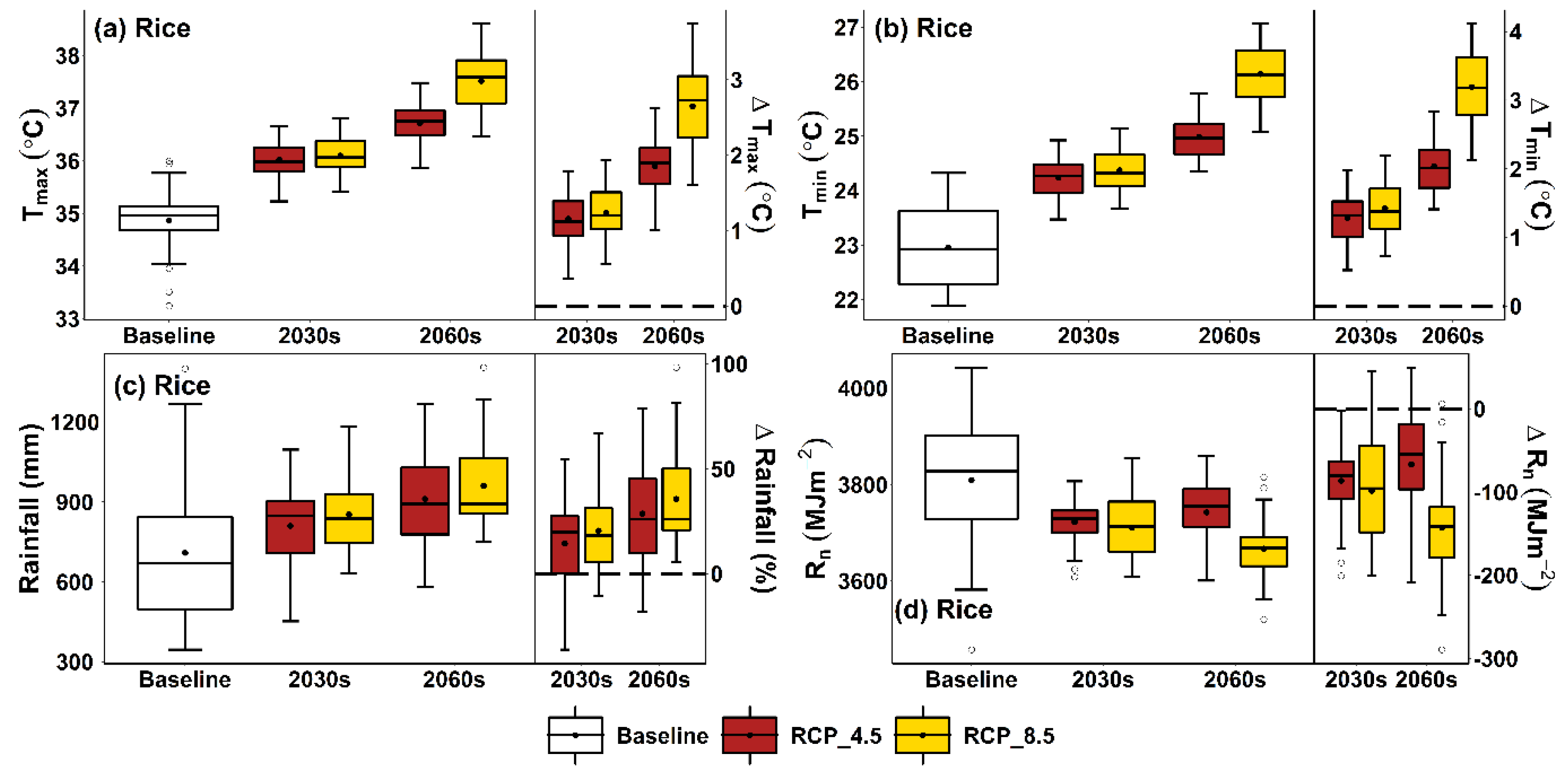
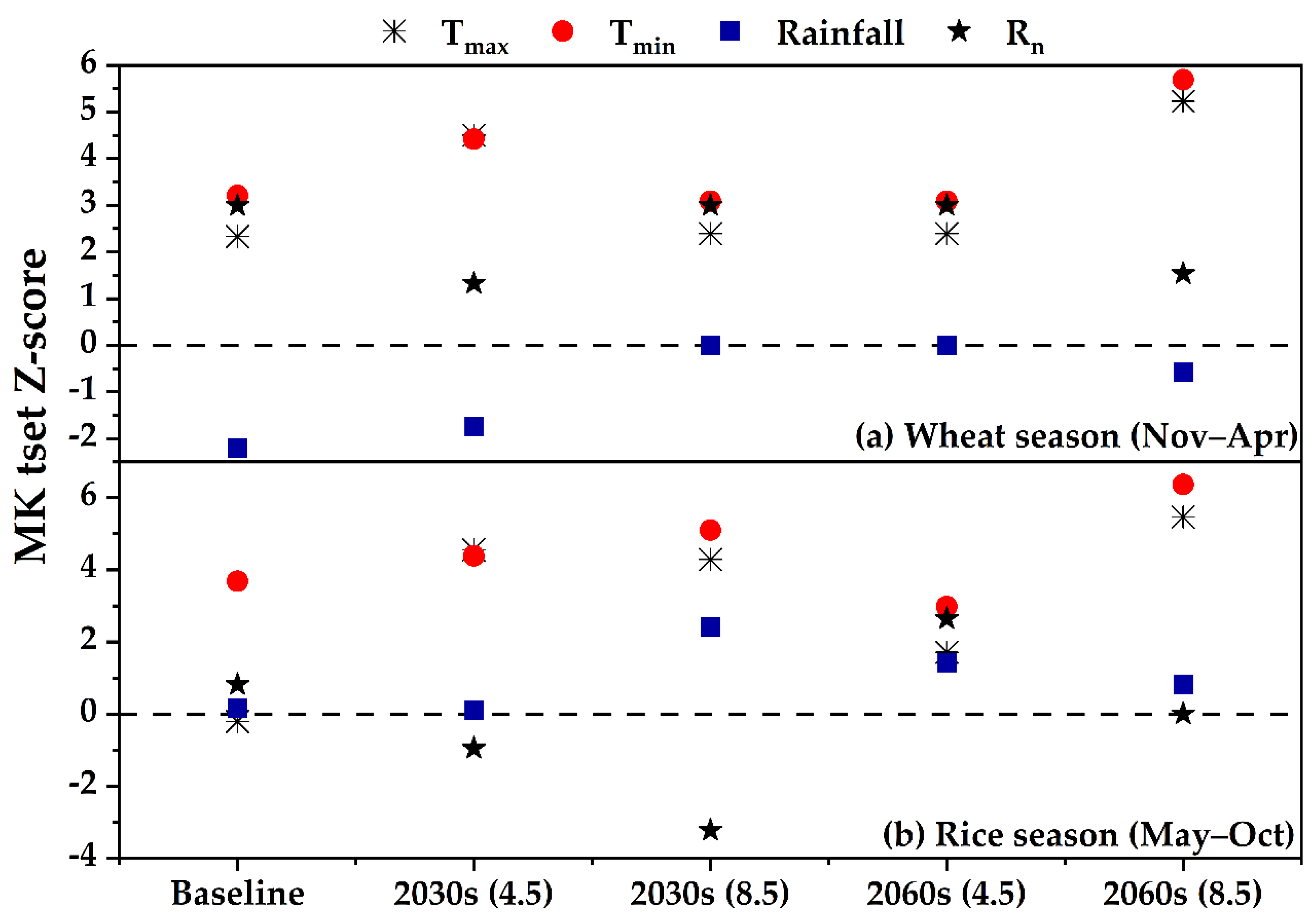
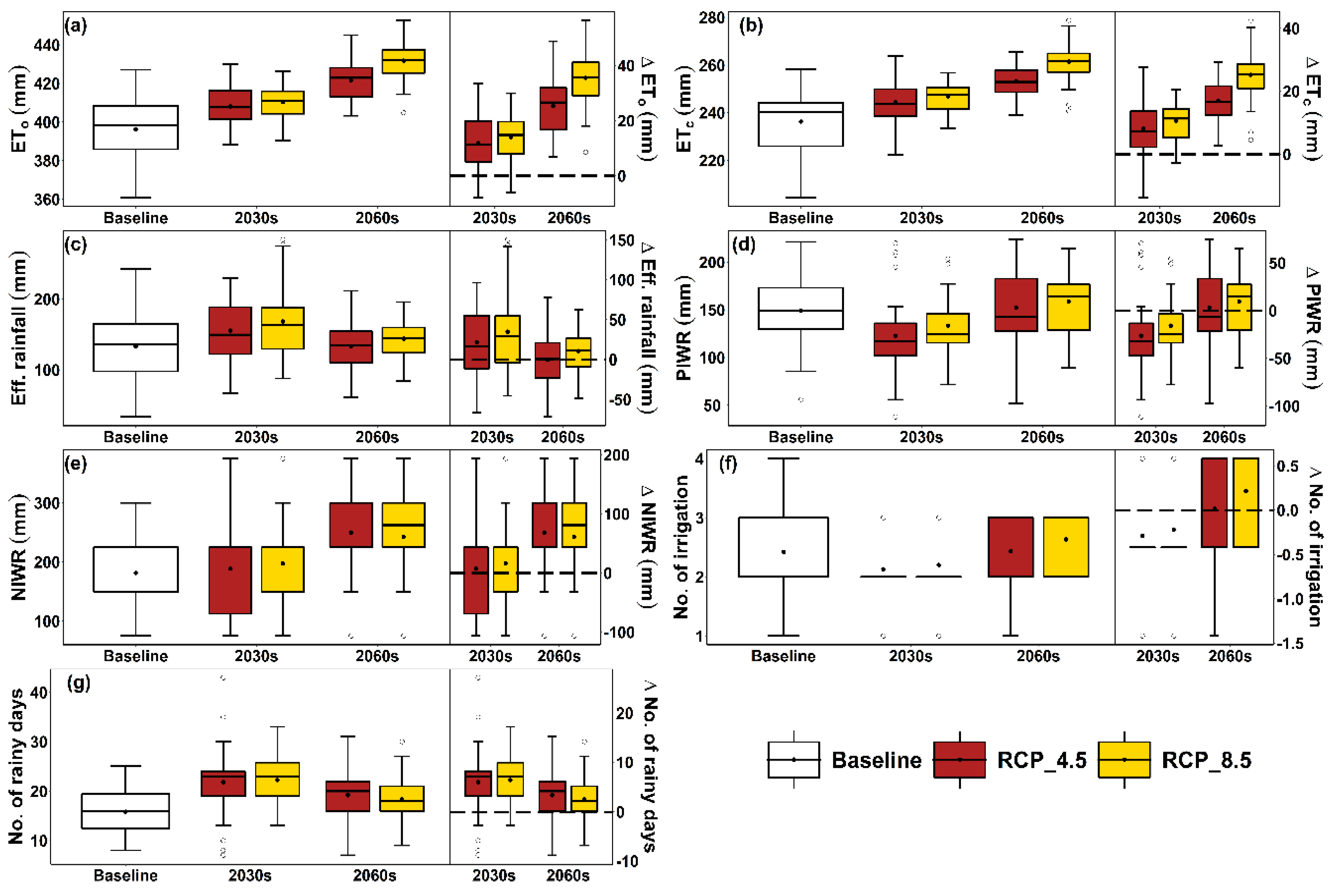


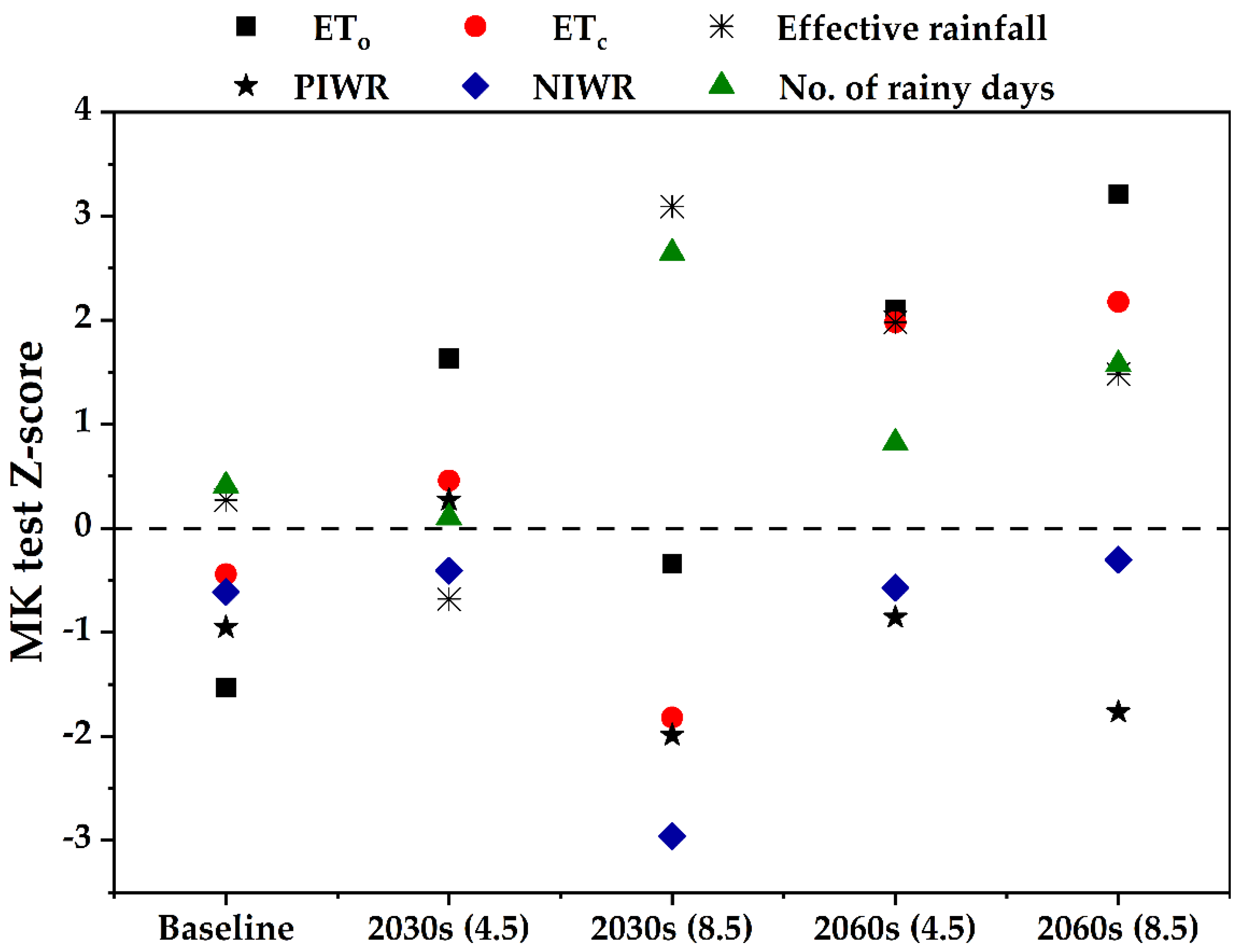
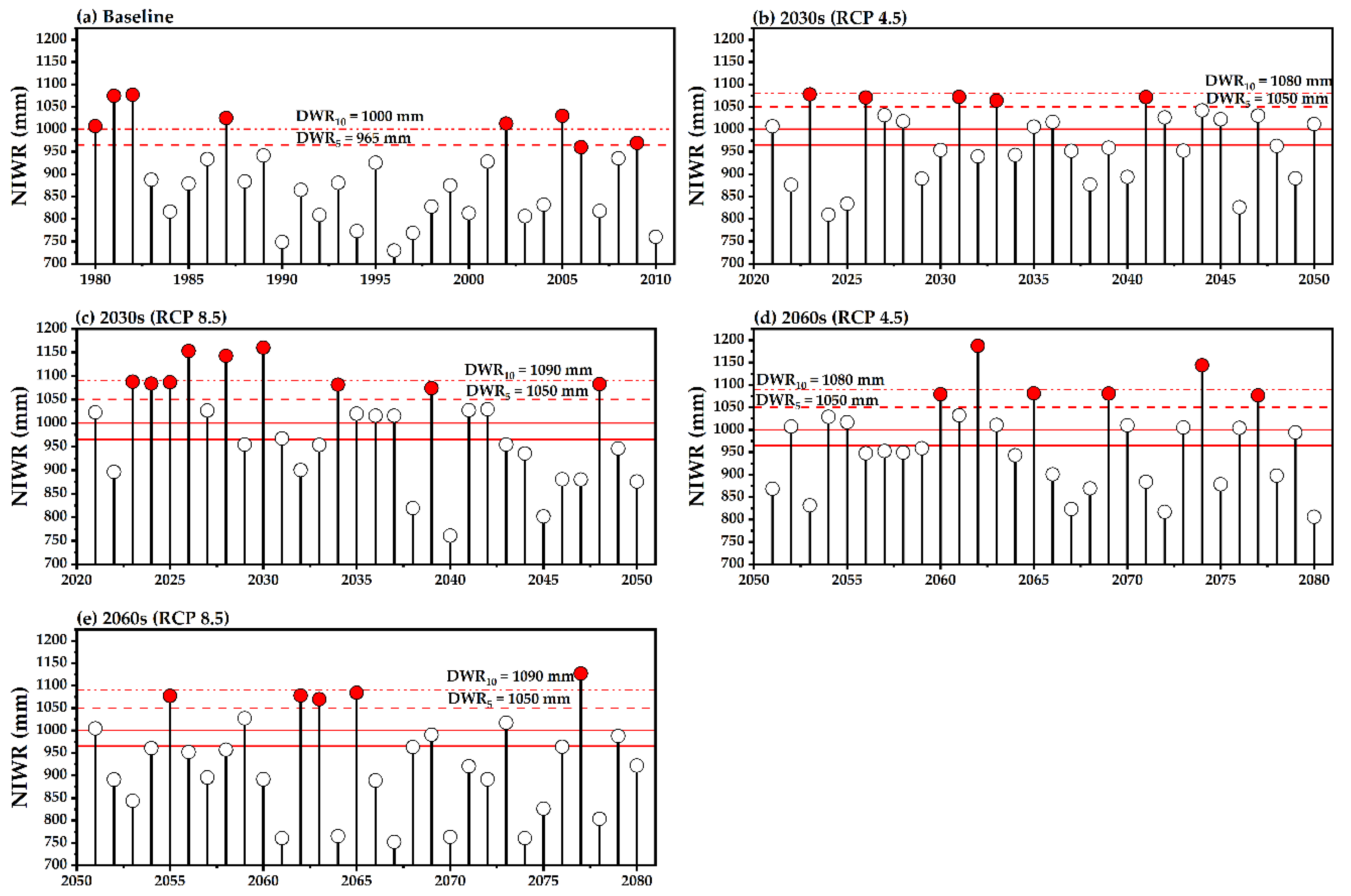
| Season | Climate Variable | Baseline (1980–2010) | 2030s (2021–2050) | 2060s (2051–2080) | ||
|---|---|---|---|---|---|---|
| RCP 4.5 | RCP 8.5 | RCP 4.5 | RCP 8.5 | |||
| Wheat | Tmin (°C/year) | 0.04 *** | 0.03 *** | 0.02 *** | 0.02 *** | 0.05 *** |
| Tmax (°C/year) | 0.05 ** | 0.04 *** | 0.02 ** | 0.02 ** | 0.05 *** | |
| Rainfall (mm/year) | −3.98 ** | −2.07 * | −0.10 | −0.10 | −0.71 | |
| Rn (MJm−2/year) | 6.10 *** | 1.48 | 3.97 *** | 3.97 *** | 1.62 | |
| Rice | Tmin (°C/year) | 0.05 *** | 0.03 *** | 0.04 *** | 0.02 *** | 0.06 *** |
| Tmax (°C/year) | No trend | 0.03 *** | 0.02 *** | 0.01 * | 0.05 *** | |
| Rainfall (mm/year) | 1.27 | 0.48 | 8.48 * | 5.42 | 2.35 | |
| Rn (MJm−2/year) | 1.44 | −1.08 | −4.03 *** | 2.88 *** | No trend | |
| Parameter | Baseline (1980–2010) | 2030s (2021–2050) | 2060s (2051–2080) | ||
|---|---|---|---|---|---|
| RCP 4.5 | RCP 8.5 | RCP 4.5 | RCP 8.5 | ||
| ETo (mm/year) | 0.48 | 0.61 *** | 0.55 ** | 0.55 ** | 0.79 *** |
| ETc (mm/year) | 0.47 * | 0.55 *** | 0.16 | 0.31 | 0.59 |
| Effective rainfall (mm/year) | −2.58 *** | −0.70 | 1.78 | −0.87 | −0.54 |
| PIWR (mm/year) | 2.30 *** | 0.86 | −0.70 | 0.32 | 0.25 |
| NIWR (mm/year) | No trend | 3.57 *** | No trend | −0.68 | No trend |
| No. of rainy days (days/year) | −0.32 *** | −0.08 | No trend | −0.05 | −0.06 |
| Parameter | Baseline (1980–2010) | 2030s (2021–2050) | 2060s (2051–2080) | ||
|---|---|---|---|---|---|
| RCP 4.5 | RCP 8.5 | RCP 4.5 | RCP 8.5 | ||
| ETo (mm/year) | −0.64 | 0.35 | −0.14 | 0.67 ** | 0.97 *** |
| ETc (mm/year) | −0.27 | 0.12 | −0.40 * | 0.66 ** | 0.65 ** |
| Effective rainfall (mm/year) | 0.28 | −0.78 | 2.61 *** | 2.57 ** | 1.65 |
| PIWR (mm/year) | −1.47 | 0.57 | −3.33 ** | −1.64 | −4.21 * |
| NIWR (mm/year) | −1.15 | −0.51 | −5.70 | −0.68 | −0.70 |
| No. of rainy days (days/year) | 0.05 | No trend | 0.375 *** | 0.18 | 0.22 |
Publisher’s Note: MDPI stays neutral with regard to jurisdictional claims in published maps and institutional affiliations. |
© 2021 by the authors. Licensee MDPI, Basel, Switzerland. This article is an open access article distributed under the terms and conditions of the Creative Commons Attribution (CC BY) license (https://creativecommons.org/licenses/by/4.0/).
Share and Cite
Ahmad, M.J.; Choi, K.-S. Climate-Induced Perspective Variations in Irrigation Schedules and Design Water Requirements for the Rice–Wheat System. Agronomy 2021, 11, 2006. https://doi.org/10.3390/agronomy11102006
Ahmad MJ, Choi K-S. Climate-Induced Perspective Variations in Irrigation Schedules and Design Water Requirements for the Rice–Wheat System. Agronomy. 2021; 11(10):2006. https://doi.org/10.3390/agronomy11102006
Chicago/Turabian StyleAhmad, Mirza Junaid, and Kyung-Sook Choi. 2021. "Climate-Induced Perspective Variations in Irrigation Schedules and Design Water Requirements for the Rice–Wheat System" Agronomy 11, no. 10: 2006. https://doi.org/10.3390/agronomy11102006
APA StyleAhmad, M. J., & Choi, K.-S. (2021). Climate-Induced Perspective Variations in Irrigation Schedules and Design Water Requirements for the Rice–Wheat System. Agronomy, 11(10), 2006. https://doi.org/10.3390/agronomy11102006







